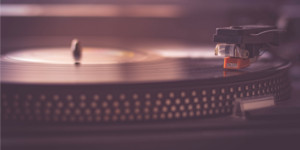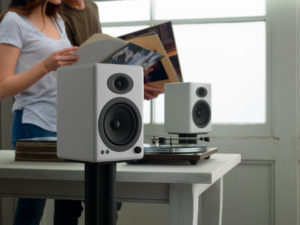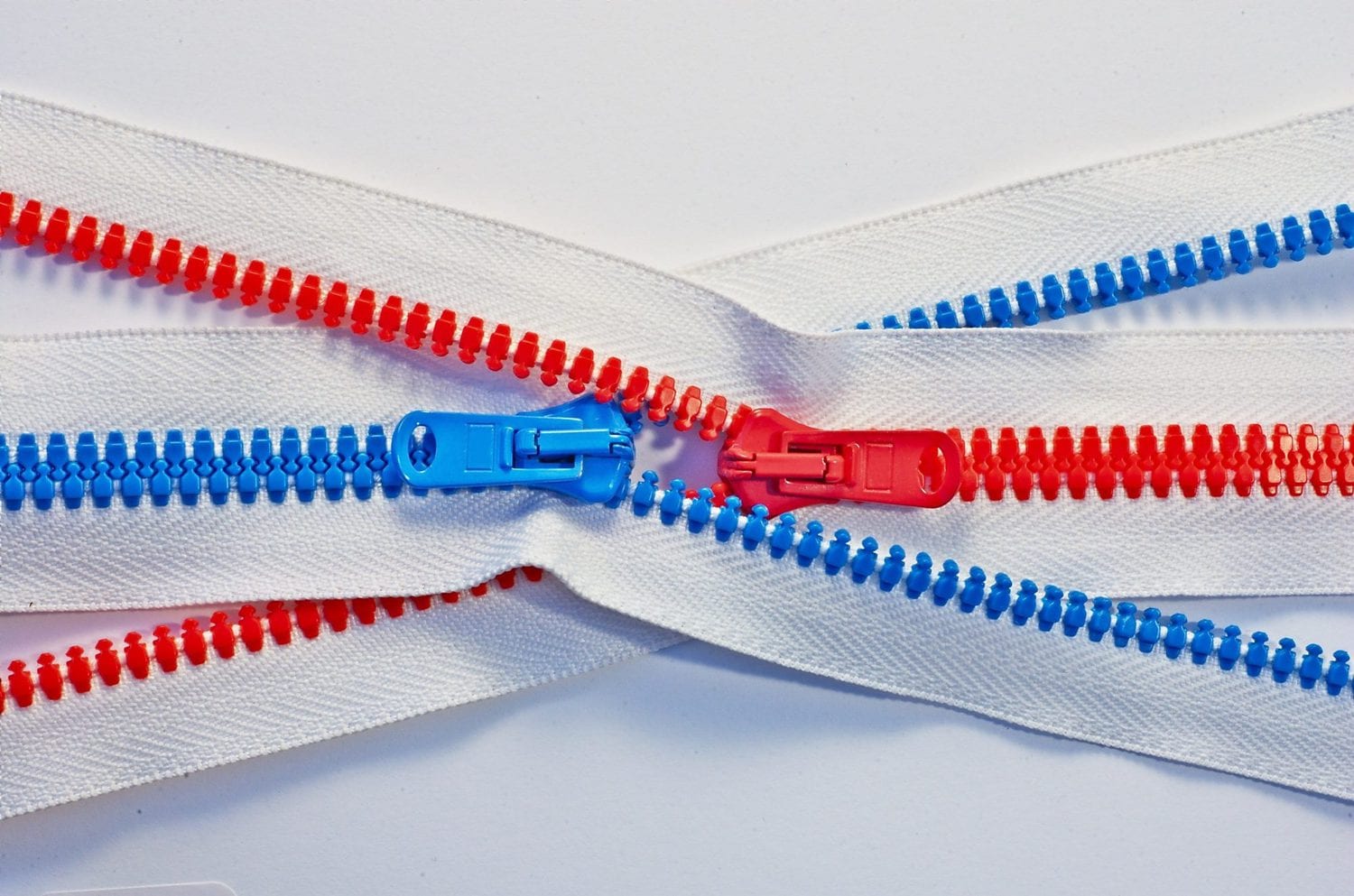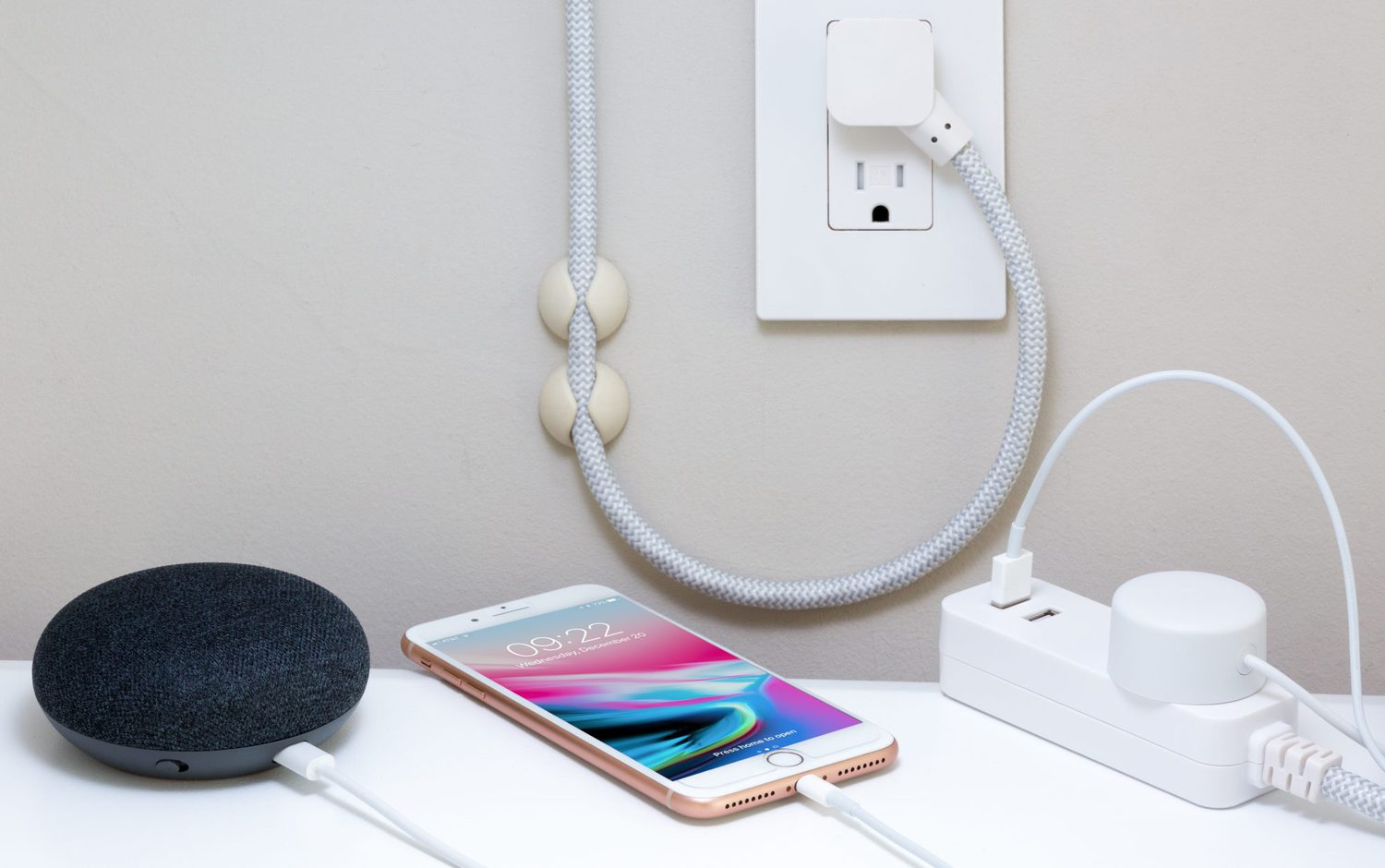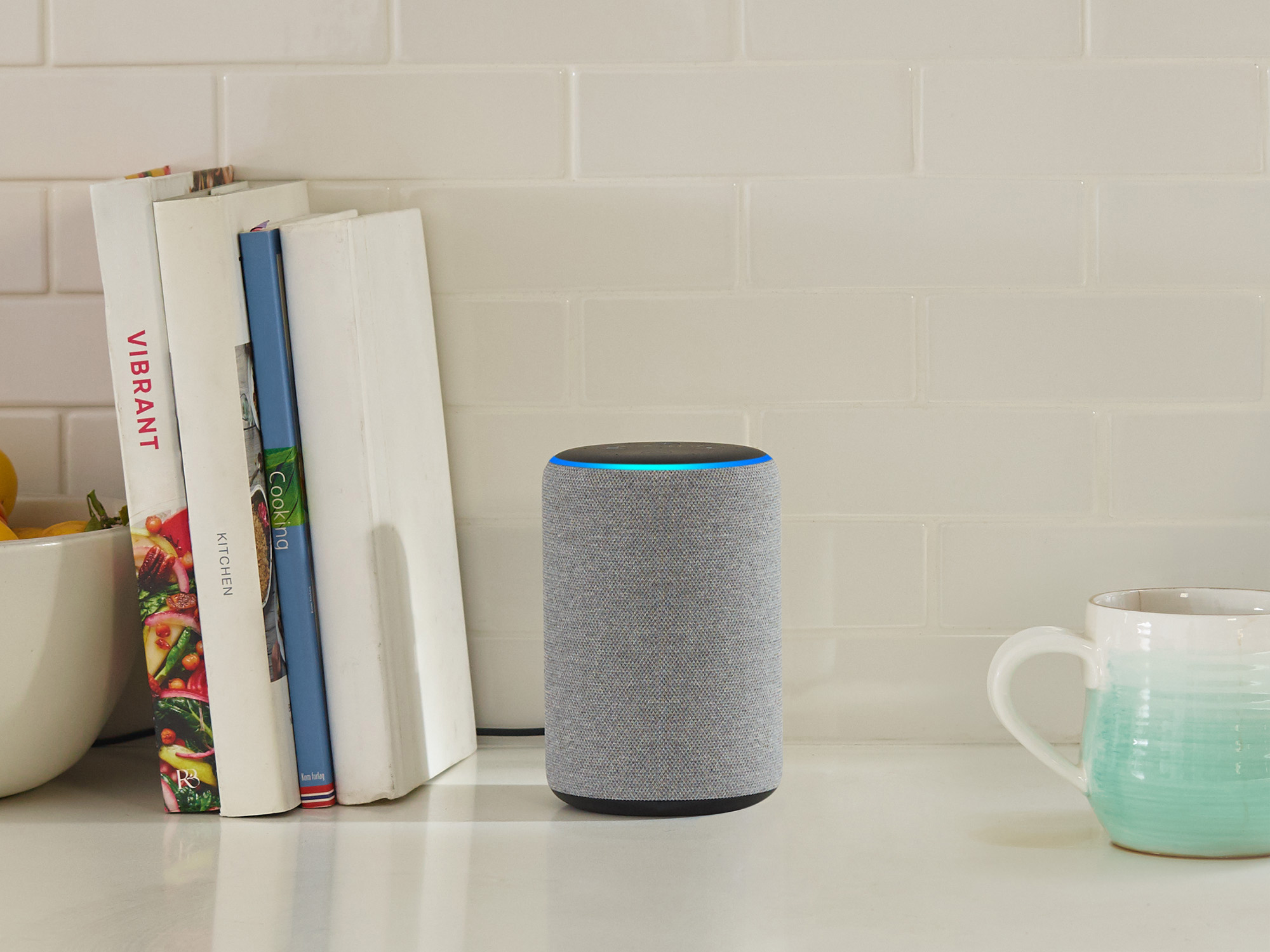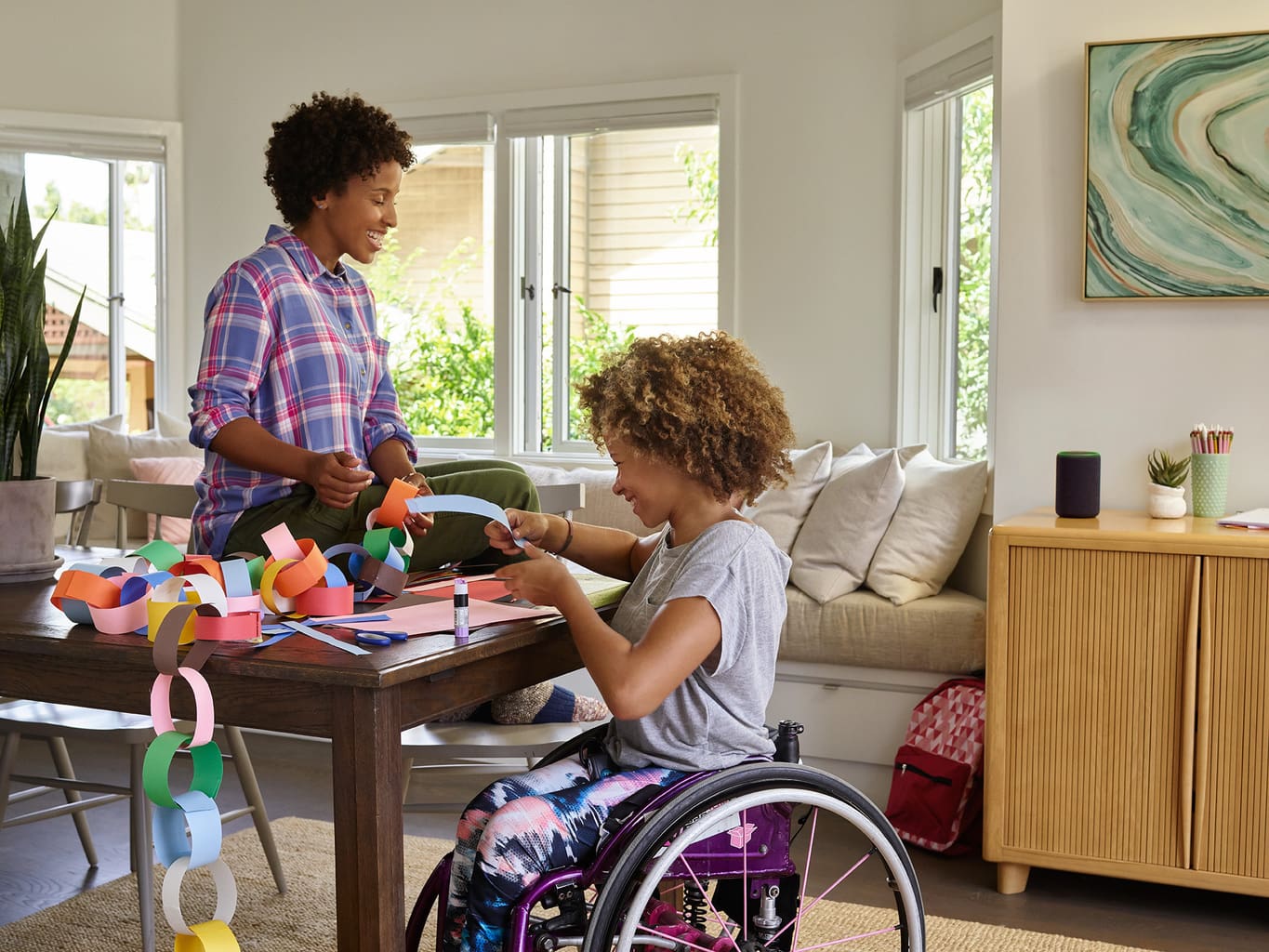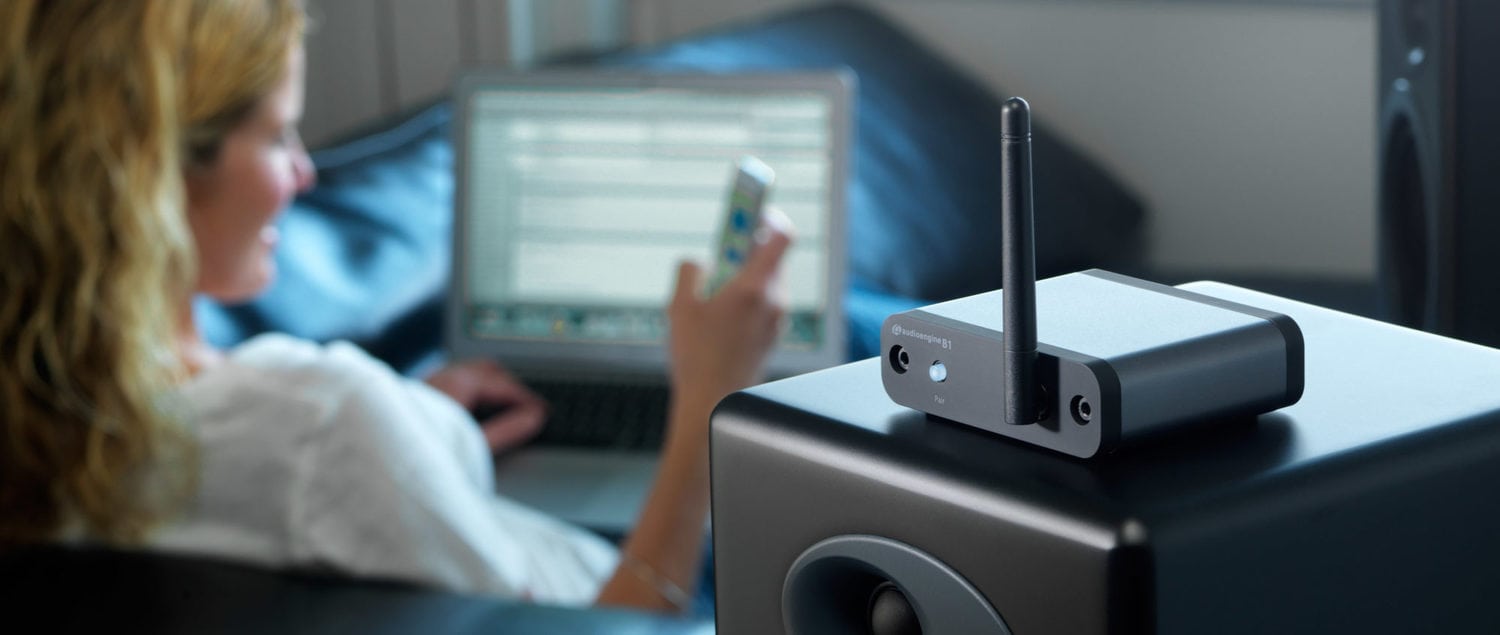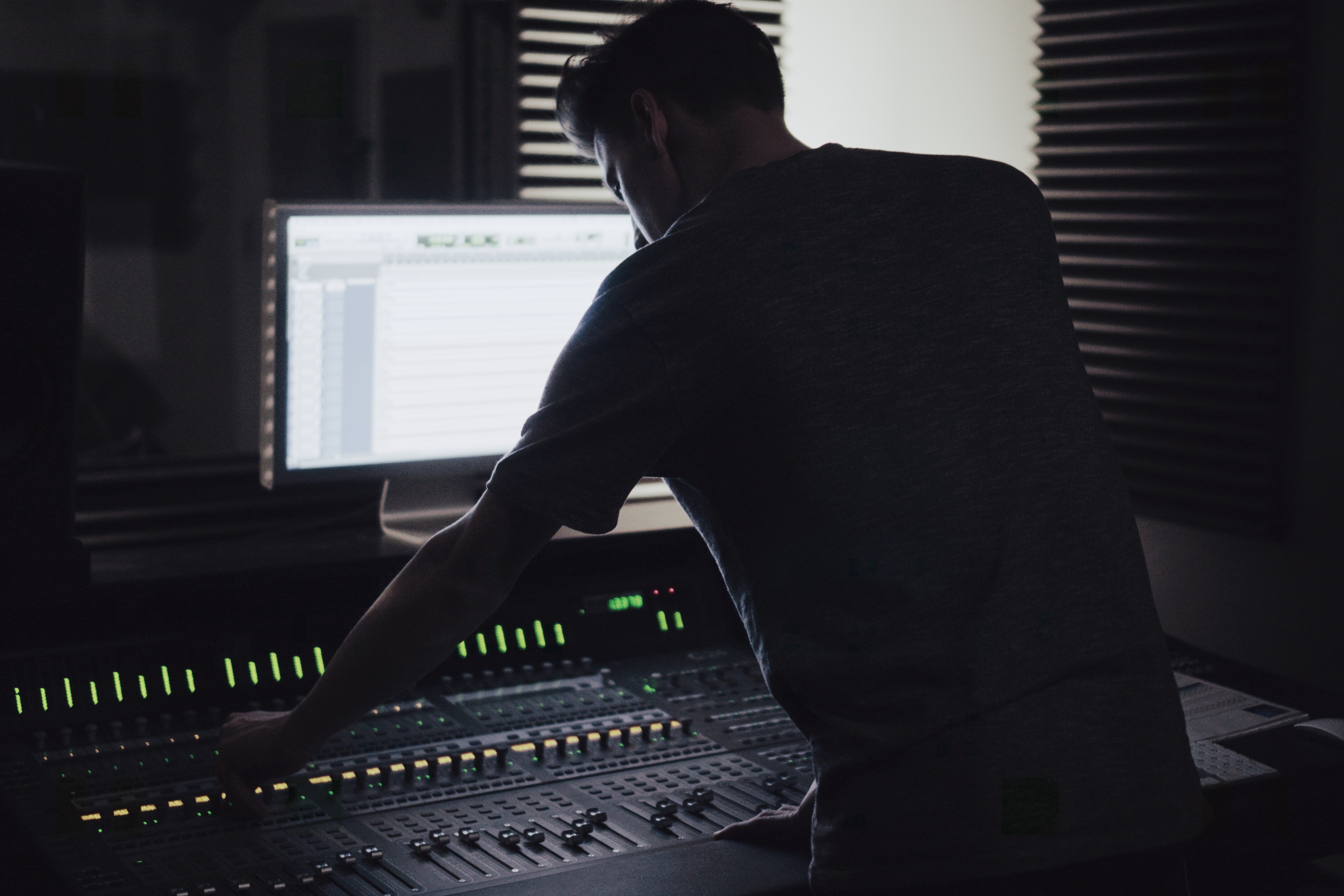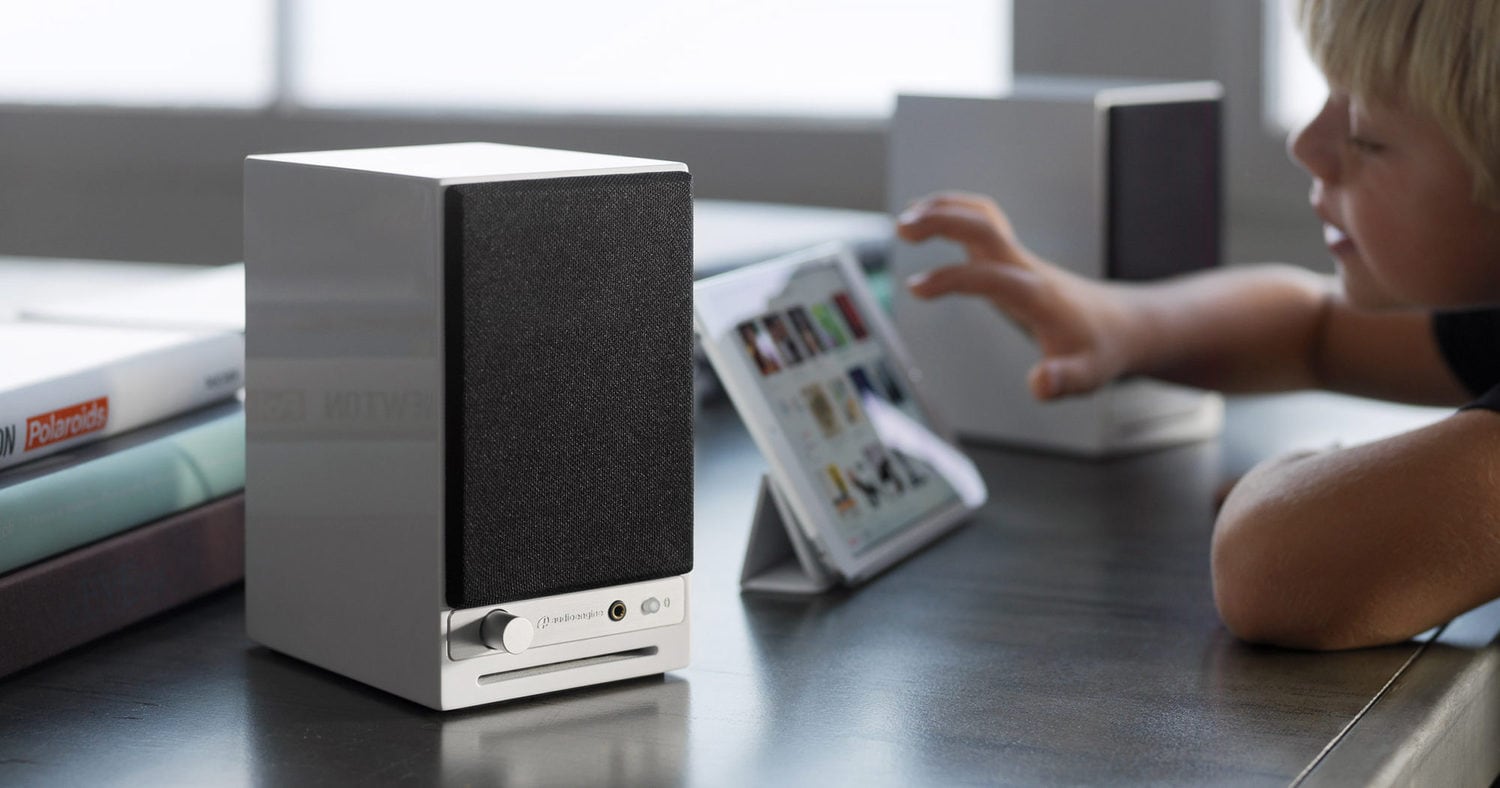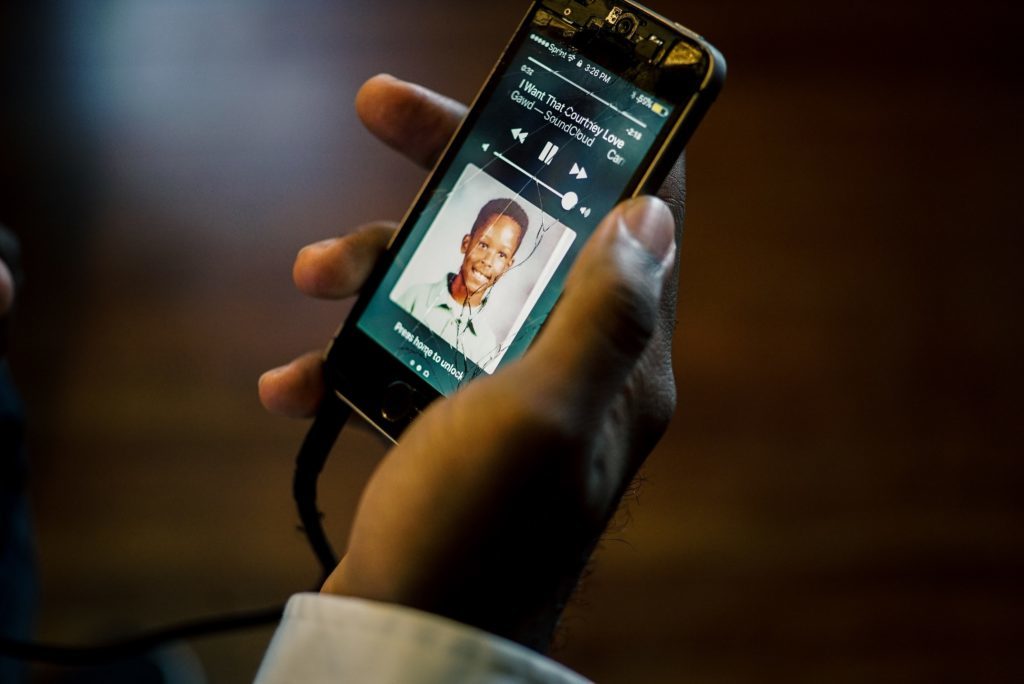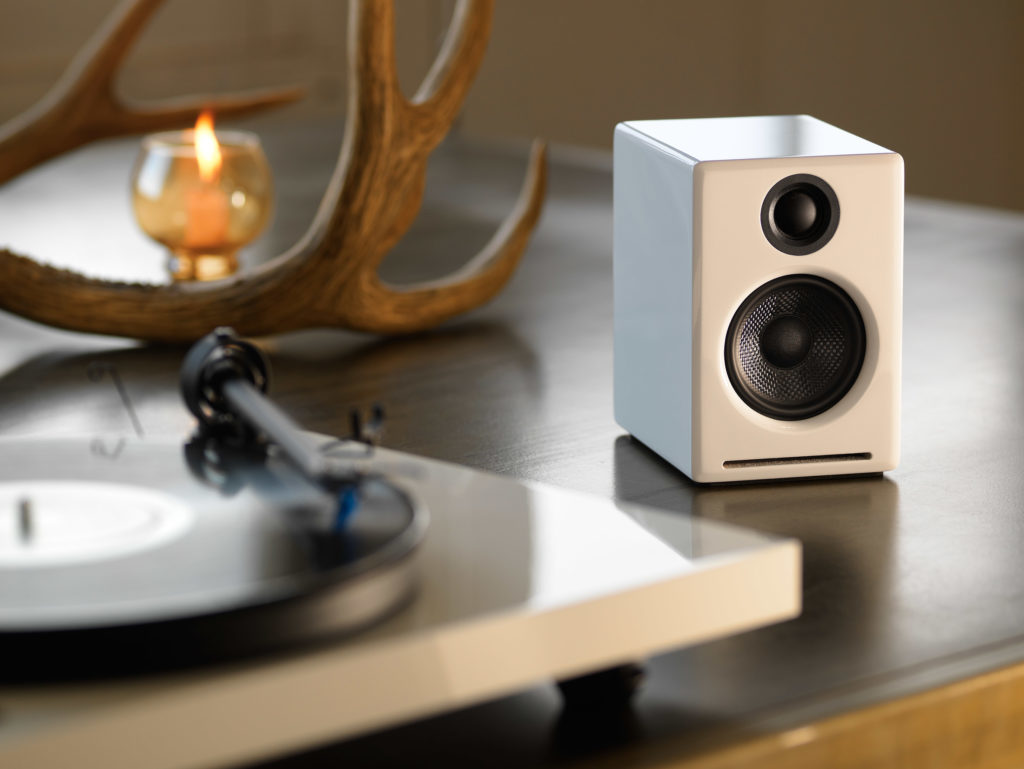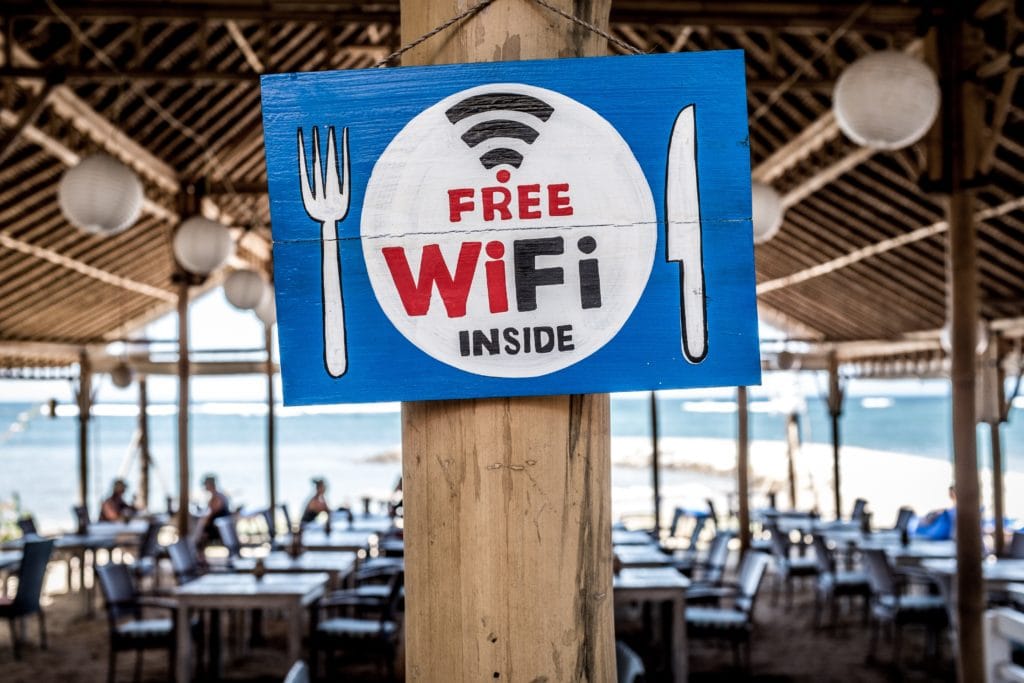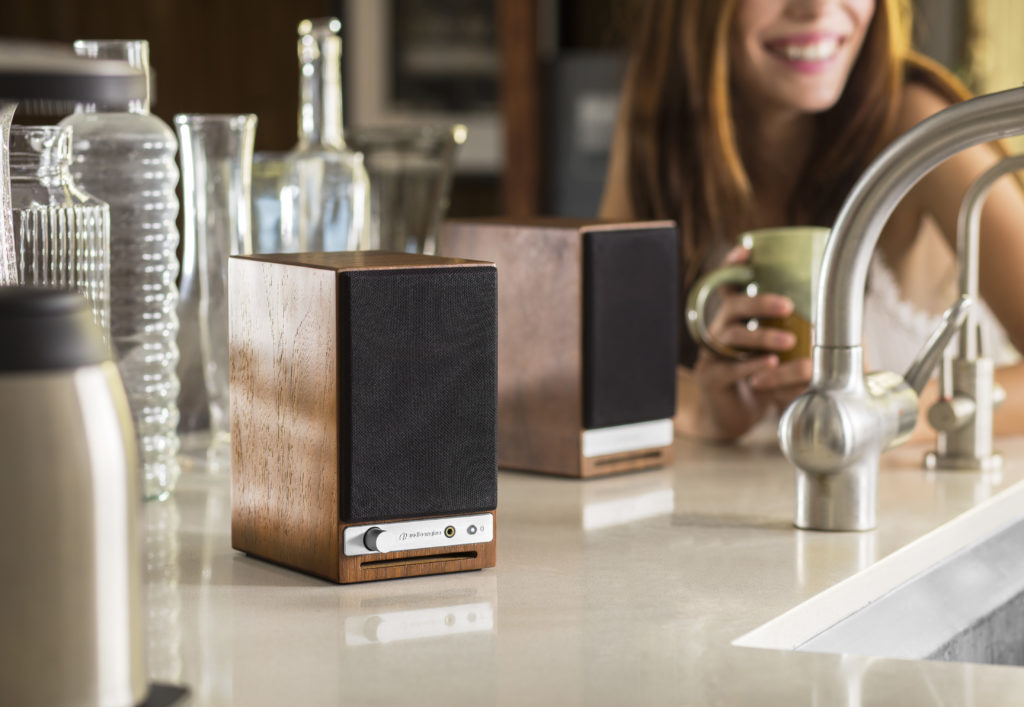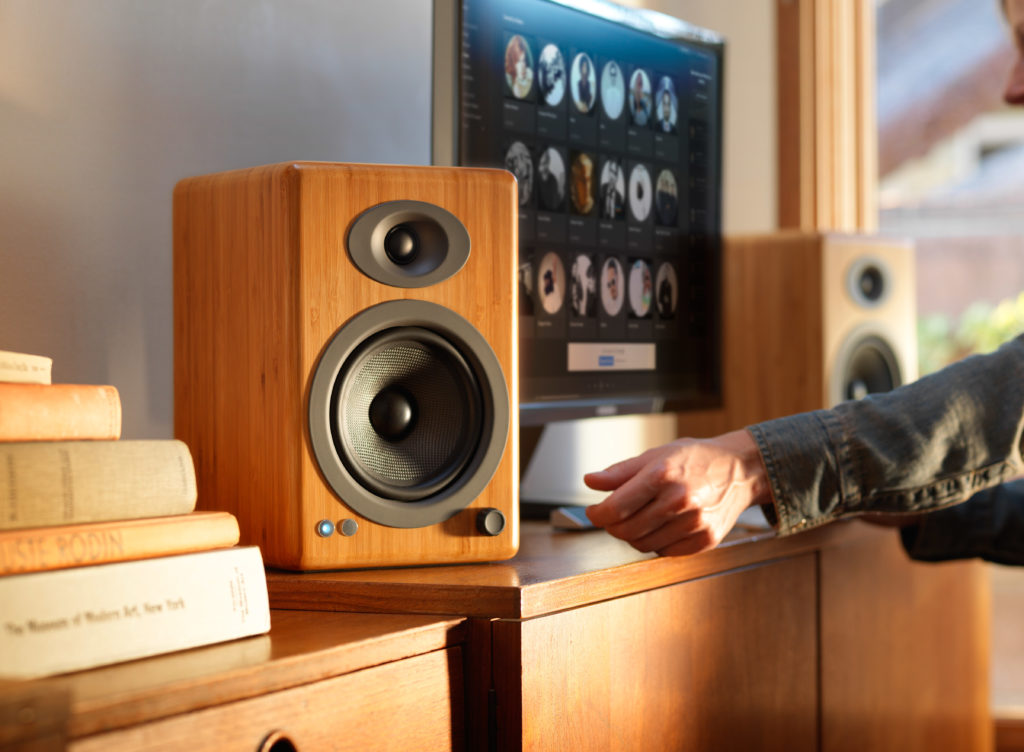Think a headphone amp is a quick-and-easy way to improve your desktop's audio setup? You're right — but your headphones matter too. (Maybe more.)
If you're wondering if an external headphone amplifier can make your cheap earbuds, like Apple's Ear Pods ($29) or Panasonic RP-TCM125 ErgoFit ($20), sound better — the answer is: probably not. Here's why:
The job of a headphone amplifier is to "amplify" the normally weak audio signal produced by the source — which in a desktop audio setup, is a laptop of computer — into one that the headphone's drivers get more out of. Without an amp or a DAC, the headphones wouldn't be able to play your computer's audio.
(The digital-to-analog converter, or DAC, is the other vital component that's usually built into most headphone amps. It converts the digital signal sent from the computer into an analog signal that the headphone amp can actually use. A DAC is only necessary when you have a digital source like a computer or smartphone, as opposed to an analog source like a turntable or CD player.)
However, the headphone amp is just one link in the audio chain and according to Dave Evans, the co-founder of Audioengine, a high-quality amp isn't going to be able to improve cheap earphones. "You can only improve to the limits of the weakest link in the chain," Evans explained "If the headphones (or earbuds) have more to give, [a headphone] amp will 'let them' give it. But if there’s no more to give, there’s no more to be had."

If you have a nicer pair of headphones whose been plugging it into your laptop or computer, that's a different story. Your laptop or desktop already has a built-in headphone amp/DAC, of course, otherwise your headphones wouldn't work with it — but it's not every good. "Most built-in amp/DAC combos are inferior simply because of space and cost constraints," says Evans. "[It's] not always [the case], but it’s a good rule of thumb."
The great thing is that if you're looking for an external headphones amp to upgrade your desktop audio setup, there are a lot of relatively affordable options. There's the Schiit Audio Magni ($99), Audioengine D1 ($169) or Audioengine N22 ($199), all of which are great headphones amp that cost under $200.
If you’re going to invest in a higher-quality headphone amp to replace the one built into your smartphone or computer, then you’d better wise up and invest in some higher-end headphones or IEMs, as well.
Music Services With High Quality Audio
Brand new music streaming and download services are waltzing onto the playing field a lot more often than we may realize.
And while a few of these services (Spotify, Amazon, Pandora) have a choke hold on the average listener, there are a number of services who are catering to the not-so-average listener. Each big streaming platform boasts its own enormous catalog of music, both mainstream and underground, but the quality is more than often sacrificed. Conversely, some lesser-known services like TIDAL, QoBuz, and HDTracks also have huge catalogs but seek to provide lossless quality audio to “picky” listeners. But since these streaming/download services are lesser-known, most users either aren’t aware of them at all, or simply aren’t aware of the differences between them. Let’s talk a little bit about all three services in hopes of bringing you the best possible listening experience in 2019!
TIDAL
TIDAL is a music streaming service offered to users on a subscription basis (much like Spotify in that regard). There are different levels of subscriptions based on the needs of the user or users. The most basic package offers standard quality audio for $9.99 per month (the same types of files you would find on every other streaming service), but they also offer a “HiFi” subscription at $19.99 per month which grants access to their huge library of FLAC and MQA (Master Quality Audio) audio files. TIDAL also offers many other pricing options that include family plans, student discounts, and military discounts.
Apart from offering higher quality files, TIDAL offers family plans, military discounts, and student discounts. They also do a great job of making sure artists are paid fair wages when their music is streamed. TIDAL even offers an offline mode wherein users can download certain songs/albums to their device and still have access to them when they have no internet connection.
HDTracks
Where TIDAL is primarily a streaming service, HDTracks is download-oriented. You would use HDTracks more similarly to how you would use iTunes, only HDTracks was designed by and for savvy listeners and audiophiles. HDTracks gives buyers the option to choose between AIFF, ALAC, FLAC, and WAV files for download. There is no monthly subscription; you simply pay per download—2000’s throwback! In keeping with HDTracks’ dedication to serious music lovers, they also provide liner notes and album artwork for the true full-package. These guys even go so far as to scrutinize their audio files to ensure they are a TRUE active 24 bits, rather than audio that has been upsampled from 16 to 24—that’s dedication!
QoBuz
QoBuz is somewhat similar to HDTracks in that they offer millions of digital booklets in an effort to stay true to the documentation of albums and their history. Initially launched in 2007 in only European countries, the application recently launched this May 2019. They currently offer four different plans in the US: MP3 quality streaming for $9.99/month, CD-quality streaming (FLAC 16-bit 44.1kHz) for $19.99/month, Hi-Res streaming (FLAC 24-bit 192kHz) for $24.99/month, and Sublime+ for a whopping $299.99/year, which offers an extended original music category along with hi-res streaming and downloading on all devices.
Among their already extensive music catalog, QoBuz also offers some top-notch editorial content that gives serious listeners that “next level” experience, and brings their following back to a point where reading about music and artists is exciting again. If there is a track you want to listen to in hi-res, and you notice it isn’t listed in QoBuz’s catalog, you can contact them and they will make an effort to source a file that will complement their selection. Pretty darn neat, right?
Listening to music seems to remain in the back seat in the world of entertainment, a position to which it began retreating several decades ago.
People are busy and as a result, we’ve prioritized convenience over depth of connection. These are three companies dedicated to shepherding all of us lost babes back to pastures of plenty. Go—get out there, and immerse yourself in a free trial!
How Do Materials Make a Difference in Speaker Construction?
As with anything, the whole can only be as good as its parts.
In our world, the world of super-duper-awesome-high-fidelity sound reproduction, this principle is paramount.
We could spend hours going over the many reasons we selected each of the small components which puzzle together to make our speakers, but today we want to talk about what are arguably, and we do mean arguably, the most important pieces of all... the speaker cones!
Since the job of the speaker cone is to essentially take the vibrations from the speaker’s voice coil and turn them into audible sounds for your listening pleasure, it is extremely important that the speaker cone should be able to accurately reproduce those vibrations without distorting. For this reason, even-tempered and consistent materials are required; in a perfect world, a speaker cone should be very rigid and durable, but also lightweight and capable of starting and stopping vibrations on a dime.
Imagine the speaker is the human vocal mechanism; if the speaker’s voice coil is the lungs, then the speaker cone is the vocal cords and mouth. That said, the shape of your mouth, the strength of your vocal cords and the muscles that control them, as well as your ability to quickly start and stop making noise, all play a role in how well your voice projects through the environment and how high/low your voice can go.
Popular materials for speaker cones are paper, metal, plastic, and aramid fiber. Each of these materials have their own sound characteristics, their own advantages, and their own disadvantages. Let’s dive right in and discuss a few characteristics of each, shall we?
Plastic
Plastic cones are a popular choice given their low production cost and the inherent consistency of build. Good sound-dampening qualities tend to be present in plastic cones, but many users (and we tend to agree) feel that plastic is a less lively sounding material than others, and tends to make the listening experience bland or sterile.
Paper
Paper cones, while brighter-sounding and more “alive,” are more expensive for manufacturers to produce. While their tonal qualities are often desirable, paper material itself is susceptible to the absorption of moisture from the atmosphere which can, in time, change the composition and therefore the tonal characteristics of the cones. There are also a myriad of variables in the paper cones--some manufacturers will treat the paper, resulting in a rounder sound. Other manufacturers use untreated paper, resulting in a bright, wide-open sound.
Aluminum
Aluminum speaker cones are, without a doubt, durable; you likely won’t be accidentally poking any holes in aluminum cones (although they could get dented if you aren’t careful). And while their sound can contain great bit of detail, they typically have little dampening (the ability to start and stop vibrations quickly). Aluminum can produce audible peaking and sort of a "slappy" sounding bass response. While many users do enjoy the detail offered by aluminum speakers, we think they can sound, well, a little... aluminum, if that makes any sense. Go to your kitchen and bang a whisk around on the inside of a metal pot and--you're right, maybe that's a little harsh but--you get the idea.
Aramid Fiber
Aramid fiber was our cone material of choice for many reasons. Not only is Aramid fiber extremely robust (it absolutely will not dent, and you would be hard pressed to poke a hole through it), but its tonal characteristics are the best of all worlds. Aramid fiber is very rigid and stiff (which is desirable from a mechanical standpoint), it responds quickly to vibration, and reproduces voice coil vibrations accurately. Aramid fiber woofer have a beautiful and broad midrange with smooth highs and satisfying low end response. The rigidity of the material provides tight “control” over the sound vibrations, and projects sound in such a way that fills the environment and immerses the listener.
It's important to experience all of these characteristics for yourself.
After all, if you are reading into a topic like this, you obviously care about your HiFi setup more than most listeners in today’s world. Everyone’s ears and tastes are different, so we encourage all Audioengine owners and prospective owners to do some A/B testing before diving in. Because as much as we want you to become a part of the Audioengine family, what we really want is for you to be thrilled with your HiFi gear; that’s why we got into this business in the first place.
Record Store Day: The Brain Child of a Record Store Clerk
We’ve all heard the old adage that history repeats itself or we’re all doomed or something like that. It’s hard to say which is true, but anyone who has lived at least 25 years has probably seen some aspect of fashion or technology recycle itself over that period of time. Take a look at the evolution of jeans, for example. The ever-popular skinny jeans or “drainpipe trousers” as they were once called, emerged in the 1950s thanks to such western stars like the singing cowboy, Roy Rogers. As time ticked on, the slim-pants look carried on through the 1960s with musicians like The Beatles and the Rolling Stones clad in painted-on denim.
Why is an audio company giving a history lesson on skinny jeans? Wait for it…
Once the 1960s hit, the trend shifted to bell bottoms as hippie culture arose. However, now that we have reached the 2000s, the skinny-jean fad has made its way back into style.
It’s important to note how things like fashion trends seem to recycle throughout the decades because the same thing happens with technology (and there it is!). There’s something magical about the crackling of a needle scraping along a vinyl disc that keeps many music lovers attached to analog sound. There’s something to be said for vinyl records and modern turntables, as many would argue that analog sound provides a crisper, more accurate representation of music than digital recordings do.
The phonograph or gramophone disc record was the primary medium for reproducing music in the 20th century. As digital media evolved from compact cassettes to compact discs to mp3 files, records have maintained continued manufacturing on a small scale since the 1990s and remain popular among a niche market of audiophiles.
One could say there is an underground record store culture that still exists today, with audiophiles collecting at least twice a year at their local record stores for Record Store Day.
With its inception in 2008 and held each year in April and November, Record Store Day serves to celebrate the independently owned record stores and their culture.
It all started as a last-ditch effort for survival as vinyl sales plummeted, and independent record stores scrapped for ideas to draw in new customers. Indie shops were starved for sales at the hands of online stores, big supermarkets and other major retailers spreading like a woods fire across the internet. The constant revival of the vinyl LP is a miracle when considering how digital streaming has taken over seemingly all other formats.
Many names can be credited to the steady development of what Record Store Day has become today, but the official idea sparked from the marketing team of an indie record store in Portland, Maine called Bull Moose Music. Chris Brown, originally hired to work as a clerk at the shop in 1991, sent an email to Michael Kurtz, head of the department of record stores. The general gist of the email acknowledged the slow sales period for record stores and recommended a day where vinyl-loving audiophiles could come hang out and have fun.
Needless to say, the idea for Record Store Day sparked national participation which has resulted in increased sales, essentially reviving the record store community.
“Indies rule,” Brown wrote. “We haven't gone anywhere. We are better than ever, and we are more important than ever before.”
The fact remains that music is powerful and moving, and it withstands the test of time regardless of the medium its played from. Whether you prefer digital or analog, we have something for every audiophile out there, including the vintage-loving record heads. You may think you’ve memorized all your favorite jams inside and out but connecting either our custom-built A2+ Wireless or A5+ Wireless speakers will reveal surprises in your audio experience that your ears have never tasted before.
Technology has come a long way since the beginning of vinyl, but we aren’t forgetting our roots.
We may not sell vinyl or turntables, but we want to perpetuate the positive vibe and culture of Record Store Day.
If you're searching for a sleek-looking stereo system to connect to your prized turntable, this is where vintage and modern combine in the best way. We're not talking about your dad's clunky, dust-ridden stereo contraption but a truly robust stereo sound from speakers built with quality materials.
Audioengine is the solution for a myriad of audiophiles, including the analog lovers. The A2+ Wireless and A5+ Wireless speakers are great options for the turntable setup of your dreams, with the modern and compact design made to leave you with plenty of room to spare for all those classic records you have to store. Our analog music systems have a warmth that you simply can't get with other similar powered speakers. And if the A2+ and A5+ still aren't tickling your retro, old-school fancy enough, we have a more classic HD-Series that is sure to curb your vintage addiction.
Because who says vintage and modern can’t live happily ever after together?
Imagine a top-of-the-line supercar made by one of the most exceptional car brands:
German, Italian—you name it.
Once the final shine is added to the exquisite Murano leather interior, and that flashy shiny beast rolls off the factory line, it appears like it was made for no other reason than for you to hop in and rule every highway in the world. Half of the car’s total weight is the twin-turbocharged direct-injected V-12 petrol engine. Heck, the manufacturer even recommends that you fill the tank up with premium fuel laced with gold flakes before taking your first joyride. This is a vehicle to be reckoned with.
Now imagine the manufacturer decides that the car is too heavy for shipment, and therefore remove that monstrous 750 horsepower engine and replaces it with a standard combustion engine. You’re beginning to catch on… this has a lot to do with the digital age standard of compressed audio.
What Is Compressed Audio?
When songs are recorded, mixed, and stored, it’s standard practice to work with equipment, programs and files that are capable of preserving the full quality of the music. Before digital audio, songs were stored in analog format: first vinyl records, then tape cassettes, then eventually moving on to CDs at the beginning of the digital age of music. Sure, these folks take up some space, but the other thing they have in common is the ability to store all (or at least most) of the data required to play your music in high fidelity. This is part of the reason why audiophiles will rave about their vinyl collection.
Digital audio files, unlike analog, are often compressed, using computer programs. This makes the file smaller so you can fit more songs on your listening devices. There are three varieties of audio file compression; each offers certain advantages:
Lossless audio files contain 100% of the audio data. Consequentially, they offer the highest-quality sound, but they also result in the largest file sizes. The two most popular formats of lossless audio files are WAV (Waveform Audio Format) and AIFF (Audio Interchange File Format).
Compressed lossless audio files are designed to squeeze audio data into a smaller file size. They still take up a lot of space, but the benefit is that you still don’t lose any audio data. Theoretically, this file type should sound identical to the aforementioned lossless audio files. Two examples of compressed lossless audio file formats are FLAC (Free Lossless Audio Codec) and Apple Lossless.
Compressed lossy audio files are made by removing certain types of audio data to shrink the file size. Lossy compression can be adjusted to compress audio a lot, or to compress audio very little. As a result, most audio file formats strive for a balance between audio quality and file size. The most common compressed lossy audio formats are AAC (Advanced Audio Coding) AAC and MP3.
“But there’s no difference, this is just a result of the placebo effect. All music files sound the same because compressed files are designed to still sound the same as files that have not been compressed. This is just one of those bogus ‘facts’ that audiophiles use to fuel their hobby and make themselves feel like their hobby is more meaningful!”
Well, that’s certainly one opinion on the matter. If you’re skeptical or just curious, we suggest you check out this audio quality test that NPR created a while back. Don a pair of headphones and see for yourself if you can physically hear the low quality MP3 file among other higher quality digital audio formats. Unfortunately, most of the digital audio that you hear is the latter: low-quality MP3 format.
We’ve come so far in the 21st Century — why do we still use compressed audio?
The first iPod, released in 2001, had 5GB of storage and could hold approximately 1000 songs. Today, smartphones offer hundreds of GB’s of data storage, allowing you to store hundreds of thousands of songs. Since we’ve really made a lot of progress on our data storage issue, and since compressed and lossy files were intended to solve data storage issues – why do we still settle for low-quality audio?
It’s habit. Compressed MP3 and AAC files are the standardized method of storing, selling, and downloading digital audio. If you want higher quality audio, you need to do a little extra work to seek out sources that offer music in FLAC or WAV format. The easiest way to cultivate a lossless audio library on your computer, though, may still be to buy CDs and rip their lossless audio directly to your computer. If you like an artist enough, go ahead and buy their album. You are more directly supporting them with your business than you are through iTunes or Spotify -- plus you get to own their music in lossless format as well.
Streaming and Compression
Music listening is evolving headlong in the direction of streaming. With affordable subscriptions from platforms like Spotify, Pandora, Play Music, and TIDAL, you can choose from libraries of millions of songs without having to download a single one of them. Most streaming platforms offer “high quality” audio streaming, and these subscriptions often cost more. For example, TIDAL offers three tiers of streaming subscriptions, including MQA (Master Quality Authenticated) quality audio files – akin to the true lossless audio files we discussed earlier.
Whether or not you decide to invest in these “high quality” streaming subscriptions is entirely up to you. It’s worth noting, though, that more entertainment streaming services are beginning to see the value in offering support for higher definition. Today’s incredibly fast internet speeds allow services like Netflix and YouTube to offer high quality audio in addition to video. These services deliver you the highest quality content possible by determining how much data your internet can handle.
Why Should You Care About Audio Compression?
Since 2005, Audioengine has been trying to bring something new to the audio market.
Our products are purpose-built for the way people listen to music today, including the breezy ease of streaming compressed audio. It’s quite likely that every second of streamed audio you hear is compressed to a fairly low quality in order to ensure that you can access your content on demand. As a proud speaker brand our goal is to give you the tools you need, including the knowledge of audio, to ensure that you are enjoying your music to the fullest.
At Audioengine, we gauge our success by the number of customers that literally smile when they hear their favorite song play through our speakers. If you’ve already made the decision to listen using a quality product such as Audioengine Wired or Wireless Speakers, it’s probably worth doing some research to ensure that you are satisfied with the audio quality you receive through whichever platform best suits your lifestyle. Your speakers are like an engine -- you ought to fuel them with the good stuff to enjoy maximum performance.
Header image courtesy of FindByPlate.com
Connecting Google Home to Bluetooth Speakers
Consumer electronics designers are, and have been, on a perpetual quest to give users the most streamlined experience imaginable.
At this point in time it seems like modern-day designers have exceeded the bounds of what most of us could have ever imagined in the first place. Think about it, there is an app for literally everything; just by downloading a simple program onto your phone or tablet, your life can become easier. Wearable technology, like Apple Watch, and smart speakers, like Google Home, tie all of your electronics together to make technology and user-friendliness a lifestyle rather than a rare luxury. Today we are going to talk a little more about one of the leading products, what it does, and how Audioengine can take it one step further; that product is Google Home.
What Is Google Home?
Offically, this piece of technology is touted as a “Smart Speaker and Home Assistant.”
A smart speaker is one of those sleek futuristic speakers that sits on your friend’s kitchen counter, plays whatever music someone tells it to, and sometimes has a snarky robotic comeback to your sarcastic remarks. There are a number of big brands making smart speakers (some of which we’ll discuss in other articles) and all of them have their pros and cons. One “pro” to the Google Home is the “Home Assistant” part. Google Home has an accompanying downloadable app that allows users to customize how the device interacts with and controls their home; lights, thermostats, coffee makers, and pretty much anything else can be controlled by Google Home and accessories. Once you have all of your desired devices properly connected and configured, turning them on and off is just one voice command away... how much easier can life get?
When it comes to music, smart speakers make calling up the right tune an absolute breeze. Google Home can control apps such as Spotify, YouTube, and iHeartRadio among others, so you can tell it to play just about any song in the world. Google Home will even call up playlists you’ve saved within your music streaming apps, and you can tell the device to increase and decrease volume, pause, skip, and any other command you would typically give a media player. There is just one drawback; while Google Home offers a few different sizes (featuring different speakers), the product’s focus is not audiophile-grade sound quality. For that, we need to bring Audioengine into the mix.
How Can Audioengine Take Google Home Further?
You’re taking a step up in the world of consumer electronics and you’ve decided to purchase Google Home; you care about user-experience and you strive to stay ahead of the pop culture curve. That doesn’t mean you have to sacrifice a quality listening experience. As I always say, what good is having access to every song in the world if you’re just going to play them through an inadequate sound system? That’s like sharpening a hunting knife so you can cut hot butter with it.
Luckily, the Google Home App (iTunes | Google Play) allows users to send audio to external Bluetooth speakers. Whether it’s the humble B2 Wireless Speaker, or a full-fledged pair of active Audioengine speakers such as the A5+ Wireless, Google Home is capable of transmitting your beloved music to your sonic system. Bam!!--we just completed the full circle of user-friendliness and ear-friendliness. It may sound complicated merely by description, but it’s actually extremely easy to configure, just follow the quick steps below:
- Download and open the Google Home App on your phone or tablet.
- Navigate to the “Devices” tab within the app
- Tap “Settings” in the devices submenu
- Scroll down to “Default Music Speaker” and tap “Pair Bluetooth Speaker”
- Select your Audioengine speaker – and you’re done!
Take control of your music.
Now you’re ready to shout voice commands all over the house and rock out while you make dinner, host a party, or do whatever it is you do. You can even connect multiple sets of Audioengine wireless speakers for multi-room audio, by creating “groups” in the Google Home app (under that same “Devices” tab).
Isn’t it nice that designers have created all this awesome technology for us? Now I’m just spit-balling, here, but -- what if one day someone will make some kind of like a smart speaker... except it lives in your brain and reads your mind. Then you can just think about how good your favorite tunes will sound through a pair of Audioengine wireless speakers, and voila!
Can Alexa Connect to Bluetooth Speakers?
Remember how in old science fiction movies a character could just talk out loud to a spaceship and it would do anything they commanded?
The idea of voice control technology has long been embedded in our expectations for the “future”, and even though most of those old science fiction movie-makers couldn’t imagine computers any further-advanced than those already available in 1979, they certainly hit the nail on the head with their forecast of voice control. Nowadays, with the help of products like Amazon Echo (and its voice-controlled personal assistant ‘Alexa’), users can control aspects of their home just by verbalizing simple commands. But even with the huge strides this technology has made in recent years, it’s impossible to get audiophile-quality sound from the speakers in an Amazon Echo product. Audioengine can help with this, but before we dive into how, let’s talk a little more about the Amazon Echo.
Is your Amazon Echo killing your audio quality?
First, while Echo and Alexa do in fact go hand-in-hand, they are not the exact same thing.
Echo is a line of smart speakers manufactured by Amazon, and Alexa is an intelligent personal assistant software used to control Echo. Users can speak aloud to give Alexa, and therefore Echo, verbal commands (always beginning with the wake word, ‘Alexa’) such as, “Alexa, play my favorite song,” or “Alexa, what’s on my calendar this Saturday?” Alexa will respond accordingly, so long as the questions asked or commands given are within Alexa’s realm of capability. With tons of Echo-compatible add-on products on the market, there really isn’t a whole lot that falls outside of Alexa’s wheelhouse.
The most common commands Alexa handles are music-related: whether it’s calling up a Spotify playlist, turning up or down the volume, or finding a specific song you haven’t heard in years but are randomly thinking about and absolutely have to hear right this second!! The accessibility is astounding, no doubt, but its main consequence is that you are forced to listen to all your music on Echo’s built-in speakers instead of your own beastly audio system. This is not to say Amazon has ignored their sound quality altogether, but realistically there’s only so much a single speaker housing of that size can handle. Suffice it to say, there are limitations.
Luckily, Amazon has implemented a crucial feature which expands its functionality to accommodate customers who want to be able to interact with Alexa and still enjoy listening to podcasts, music, and stock tips through exterior systems. That’s right, it’s quick and easy to connect your Echo to Bluetooth speakers:
- Open the Alexa App (Apple link | Google Play Link)
- Tap the “Devices” icon and select the Echo device you want to connect to speakers
- Select “Bluetooth Devices”
- Select “Pair New Device”
- Find your Audioengine Wireless speaker on the list of available Bluetooth devices
Bang, you’re done!
Now you can treat Alexa as if it were any other input device; you can still have whatever other devices you so choose connected to your Audioengine speakers, and since Alexa can control Echo’s volume with a simple, “Alexa turn down volume,” you can leave Audioengine’s volume knob exactly where you like it and adjust volume accordingly with Alexa. If you have our S8 Powered Subwoofer connected wirelessly to your mains, this configuration will still work which means you’ll get full-spectrum high fidelity audio when listening to all your favorite songs, without sacrificing the unparalleled convenience provided by a product like Amazon Echo. This will also work with our standalone B1 Bluetooth Music Receiver in the event you have a set of wired speakers you want to turn into wireless speakers.
Modern technology is really opening up doors... and windows... and exhaust fans... it’s basically blasting the roof off the whole place.
We are reaching the point where we can do just about anything we want with voice control technology, as long as we have all the right accouterments. Products like Amazon Echo make life so easy it hurts... perhaps it hurts so good that you want to lie down and say, “Alexa, play ‘Hurts So Good’ by John Mellencamp.” Don’t worry – we designed Audioengine Wireless speakers to do the rest.
Audioengine works with Spotify and Pandora
New music is everywhere.
These days you can’t go anywhere without discovering some up-and-coming artist, or even a seldom-heard indie music hero. Hardware stores, doctor’s offices, hair salons, the TV, the car, the bus, the airport... the world has evolved to help us discover what is otherwise nonexistent to us. Easy-to-use music streaming services are no exception. If you were around in the early 2000s and were astounded with the accessibility offered by companies like Napster and KaZaA, then you are likely on the verge to have your mind literally blown to pieces by media platforms like Spotify and Pandora.
Why Are Spotify and Pandora Important To Audiophiles?
In the early days, when Napster roamed the Earth, users needed to know exactly what songs they wanted to hear.
They had to search for their music, identify the best file -- weeding out any partial tracks, or tracks that weren’t what they advertised themselves to be -- and then wait however long it took for the file (or files) to download onto their machine before being able to listen to a painfully degraded and over-compressed MP3. It was miserable, but it started a revolution. Years later, we were given Pandora and Spotify. Internet speeds, music databases, and performing rights organizations have all adapted to the current technological climate, and we can now retrieve our searches and stream the results instantly, and in markedly higher quality than ever before.
Both Spotify and Pandora have HUGE databases full of today’s most slammin’ hits, oldies untouched by time, and millions of tunes rumbling around in the underground. Local, regional, national, and world-famous artists can ALL get their music onto these platforms easily. Artists can get paid (they aren’t making a fortune but they are getting royalties per play), and can be discovered through playlists and radio stations -- features celebrated on both platforms. Spotify and Pandora both offer free versions with limited catalogs, as well as paid versions with extended catalogs and high-quality playback options. While neither platform offers downloads of gigantic files featuring completely lossless audio, they do both offer some pretty great alternatives which allow the music to breathe and be heard, to most, as it was meant to be heard
Radio stations and playlists tailored carefully to each user’s listening habits help users discover new music on a daily basis; music they would never have been hip to otherwise. This is potentially the single most important thing for true audiophiles. Yes, super-expensive gear is important to a lot of audiophiles, but what does all that crazy equipment matter if we aren’t pursuing something beyond “comfortable” or “familiar?” As audiophiles we embark on a journey which, at the beginning, is known to have no true end. The goal is to perpetually expand our musical knowledge and musical repertoire; to listen with intent to any and all music we can possibly get our ears on. Just as important as the expensive gear we desire, is the never-ending selection of music our world now has to choose from... and it’s right at the tip of our fingers.
So Where Does Audioengine Come In?
Imagine your best friend just introduced you to the most beautiful, intelligent, funny, and even-keeled romantic prospect of your entire life.
You hit it off! You and this mystery person have much in common; you’re learning loads of new things about them, and you’re so PUMPED about the idea of spending more time with them you could burst with tears of joy. At the end of this rendezvous, however, you realize neither of you have a cell phone, a pen and paper, or any general idea of where you live or how someone would get in contact with you.
Alright, so that analogy was a little ridiculous but, hey, how rotten would that be!? It’s the same thing as this whole Spotify, Pandora, Audioengine dynamic.
You have all this incredible new music just waiting to be unearthed, and it’s right in front of your face; one click away from your ears. And then... you realize your speaker system is absolute garbage.
Not only does your system sound terrible, but the sanctuary that is the user-friendliness of Spotify and Pandora is rendered almost completely useless in the grim shadow of your outdated speakers and their lack of basic sonic functionality.
To bring Audioengine into your home is to invite solidarity; to create harmony. Spotify and Pandora will work on any device that can access the internet, be it a tablet, laptop, smartphone, or desktop computer. And Audioengine speakers, via aptX HD Bluetooth technology, connect instantly and seamlessly with any and all of the aforementioned devices. With Audioengine Wireless Speakers, not only can you stream music to your speaker system just as easily as you can FIND that music on apps like Pandora and Spotify, but our speakers actually enhance the audio even further, taking the experience to an unprecedented level in both ease-of-use and audio fidelity.
The only thing more rewarding than discovering a new song worthy of filing in your “absolute favorite jams” folder, is hearing that new song for the first time on a pair of speakers that allows you to hear every beautiful detail; that separates every instrument perfectly from the next; that lets the mix breathe and sing and speak in a clear (and sexy) voice; that makes you continue the search, evermore, for your next most favorite song.
Audioengine Works With Tidal
Despite the pull of two music industry giants -- Beyonce and Jay-Z
Many avid music listeners are still not sure what exactly TIDAL is or why they should be using the platform. In the world of music streaming services, TIDAL is still a less popular contender next to platforms like Pandora and Spotify, but there are a number of benefits to this unique streaming service. Today we’re going to talk about a few of the features that set TIDAL apart from other services, and how Audioengine can help further enhance your TIDAL listening experience.
What Is TIDAL?
Apart from being owned by music moguls, most people don’t know what make TIDAL special.
One thing everyone should know about TIDAL is their mission to advocate and nurture up and coming artists. TIDAL offers specific subscription tiers geared towards creating unique creative experiences between artists and their fans. Exclusive video and audio content is procured through TIDAL and offered to serious fans who want a deeper connection with their music and the artists creating it. The monetary benefit for artists is also heightened through TIDAL’s royalty payouts, which supersede just about every other popular streaming service. Implementations such as these are just a few of the things that prove TIDAL’s dedication to the arts, and for those of us seeking something more out of our music, this is a beautiful thing.
You've been waiting for me to say it.
Sound quality is one of the most unique advantages of TIDAL which is why many users choose it over other music streaming services. Most streaming services provide files in either MP3 or AAC formats, and while these file types aren’t always an abomination, they are certainly lacking in depth and liveliness due to many bits of information having been compressed away. TIDAL offers high fidelity streaming options in the form of both FLAC (Free Lossless Audio Codec) and MQA (Master Quality Authenticated).
FLAC is essentially akin to listening to a CD. The codec stores audio information at CD-level quality when converted to/saved as a digital audio file. TIDAL has a library of roughly 48.5 million songs in FLAC format.
MQA format is truly supreme as it’s the only streamable audio that does not compromise the integrity of the original sound. This allows listeners to hear the music just as it was recorded and mixed, which goes back to a few of our other articles about the importance of hearing the music as the artist and producer intended.
Where Does Audioengine Come In?
Great question; we knew you were wondering. We'd like to begin answering that with another question:
What good would TIDAL’s enormous database of high fidelity music be if you didn’t have any gear that could handle it and recreate it properly?
The fact is, you can play an immaculate audio file over a lousy pair of speakers and guess what?--it’ll sound lousy. So the first way Audioengine helps is to provide a proper outlet for all this high quality audio. We make sure every pair of our speakers is tuned to perfection to provide a broad, tangible, and three-dimensional soundstage that gives TIDAL audio an opportunity to seriously sparkle.
If you’re interested in wireless audio...
It’s important to remember that you can lose audio quality every step along its way from your source to the speakers. One of the greatest offenders is -- you guessed it – sending audio through the air instead of through a wire. But it’s not the atmosphere’s fault—the culprit is actually low-grade Bluetooth systems! Thankfully, Audioengine Wireless products utilize aptX HD Bluetooth codec which is the highest possible Bluetooth quality. When you set up a Wireless Audioengine product, it only takes a brief trip to your device’s wireless settings or to Audioengine’s Bluetooth Organizer App and you’ll be streaming high-quality audio from anywhere in your home with unbelievable ease.
Audioengine is proud to consider themselves one of the industry leaders in changing and improving how we consume audio. It’s our responsibility to identify partners, such as TIDAL, with whom we are philosophically compatible and work towards a confluence. When all the right pieces are in place, your listening experience should become elevated, something brand-new… and we think you’ll love it.
Our Speakers Won't Spy On You
Lately there's been plenty of concern surrounding smart devices.
Moonlight pours across the desk in skewed rectangles. A smart speaker waits patiently, inches back, tucked loosely into the shadows; its nose tickled by the dimming smell of coffee and cigarettes. The speaker taps its fingers in a brief fit of anxiety as it listens for the wake word... the word of all words... the signal. Once the word is heard, this scoundrel will pounce. Some unlucky man or woman, somewhere, will wake in the morning’s wee hours with the smart speaker’s cold black eyes cast upon them; they will watch as a malign smile jots its way across the speaker’s otherwise expressionless face...
Alright, so this is a bit extravagant, but there is a lot of concern out there about people being spied on by their smart devices.
It’s no secret your smartphone listens to your private conversations, your laptop knows where you are at all times, and your tablet can list every item in each one of your pants’ pockets (fantastical, still, but you get it). But the real fact is, more often than not, we inadvertently give our devices and apps permission to practice espionage. How? Typically, this happens when our devices prompt us with some updated terms and conditions and we habitually click “agree.”
Technology is getting scarier
So what about all these new smart devices like Alexa and Google Home; products that seem to be listening to literally every sound within range at every moment of the day. Sounds like a legitimate concern when you think about it that way. To put it simply, these devices are not supposed to be recording all your conversations, only the ones prompted by the device’s “wake word.” This is the assigned phrase that triggers the device to start recording speech, interpreting it, and acting accordingly. Until the wake word is uttered, these devices are supposedly only listening for the wake word and nothing else. This is admirable and responsible of the products’ respective manufacturers, but there have been reported cases of glitches that have led to private conversations being sent to third parties... which is scary.
Although glitches are rare, they do happen and they can be unfortunate.
Aside from glitches or “misinterpretations of command,” other mishaps can occur such as “dolphin attacks.” Dolphin attacks are commands being made to a smart speaker in a frequency that the human ear cannot hear -- research has shown that these types of commands are possible and can control the device. Smart devices can also be used as spying devices for law enforcement, and tech aficionados have said that hacking a smart speaker is about as simple as hacking anything else in your home; and turning a smart speaker into a spying tool can be done with some savvy coding.
Some people don’t have any issue with these potential risks, and that’s fine too; not knocking it! But for those of us -- and there are a lot of us -- who would rather play it safe, there is a great solution; simply minimize the amount of smart devices that have the potential to listen in. Some devices, like our phones, are absolutely necessary weapons for survival in modern life, but others just aren’t.
Do Audioengine Speakers Listen In?
To put it shortly, heck no!
Our speakers are just speakers... but really awesome ones, though! Even though many Audioengine products implement wireless audio (Bluetooth), we have not integrated any voice recognition or voice command technology. Our wireless products only allow you to send audio recordings from one device to another, and cannot be hacked or coded into doing something else. Some people enjoy calling out commands to their smart speaker, but if you are comfortable using a smartphone, you can just as easily play a song by opening Spotify. There's no risk of misinterpreted voice commands or your conversations leaving the room--even if the only thing that leaves the room is you saying “Alexa, play ‘Pour Some Sugar On Me’ by Def Leppard.” Spooky, yes?
At Audioengine, we love the idea of our speakers becoming a part of your home.
Our designers strive to cultivate an elegant style that complements your furniture collection. Our engineers work hard to bring you a tool to satiate and enhance your sonic palate, but quite frankly, that's it. We aren’t out to hear all the weird stuff you and your friends talk about -- not that you don't surround yourself with awesome people who all have an impeccable sense of humor. We just want to give you a product that you can use to jam to some killer tunes through the best sounding speakers possible... is that so much to ask!?
Spoiler Alert: there's a cure.
We have all heard a friend, foe, or even heard ourselves say, “man, I just don’t seek out new music anymore,” or, “I can’t listen to the music coming out these days.”
Unfortunately, this trend is actually backed by some hard numbers. I read an article recently that claimed, and supported with statistical data, most people stop seeking new music by age 30. I was appalled by this ridiculous claim at first, but the more I thought about it, I realized I too had been attacked by this dreaded musical paralysis, which creeps across the land plaguing thirty-somethings ‘round the globe.
It’s a sad fact to come to terms with, but in order to fix a problem we have to first acknowledge its existence.
Don’t worry, this is not your fault, nor should you feel like you have done anything wrong to cause your musical paralysis.
As we grow older, there are a number of things that happen to us, all of which can compromise our musical tastes, how much time we dedicate to listening, our connection to music in general, etc.
For instance, most young people do the majority of their music listening in the car; there has always been something particularly liberating and inspiring about this ritual. As we age, however, our ears start to hurt from the way our car traps sound; we have to take phone calls too often while driving; maybe we’re driving around with our kids in the back seat and if we happen to be listening to music at all, it’s children’s music. All of the above distance us from music.
Another issue with listening in today’s world is the quality of our sound systems.
Don’t get me wrong, technology has come a long way and there are some incredible sound systems out there, but most of them are too expensive for the typical consumer.
And let’s be honest, although technology has advanced to allow for some incredible systems to be made, it has also allowed for some terrible ones. To our great misfortune, the most accessible systems also tend to be the lesser quality ones: inexpensive earbuds, laptop speakers, PHONE SPEAKERS! Yes, these systems make it easy to access music, but they don’t let you experience it.
Remember the days when every experience you ever had was tied to a song?
Think back to when you got your first car. What did you listen to on that first solo drive? What did you listen to the first night you went off to college? What were you listening to after your first heartbreak? When we were young, every moment was highlighted with music, and that very music (scientifically speaking) is part of why we remember those moments so well. Music and the human condition go hand in hand; they were made for one another.
So how do we break free of this sudden musical paralysis?
Like any other relationship, we have to TRY.
We have to make time for music; plan dates...seriously! Set aside an hour every night to listen to music, or how about instead of watching so much Netflix, we listen to one old album and one new album. Rediscovering our old favorites is just as important as seeking out the new. We have to get excited about music again, and in order to do that, we need to be able to hear it in a new way. That’s where Audioengine comes in…
Audioengine speakers have an award-winning soundstage that lets us hear details we’ve been missing for years.
Right now, you probably think you’ve heard your old favorites so many times, you know everything happening at every moment. Audioengine’s mission is to change that. When you start jamming to the classics on Audioengine speakers, you will hear ear-candy you didn’t even know was there, new instruments will pop up out of nowhere, the vocals will speak seem to converse with the strings and the entire work will have new life. This also applies to newer music.
Everyone likes to criticize this “crazy music the kids are listening to,” but the truth is, there is actually some really brilliant work being done this day and age... granted, it’s hard to tell when you’re blasting your laptop speakers into oblivion. Maybe the reason a lot of us stopped seeking out new music is that we lost faith in our ears, not in the music itself.
Music is vital to human life. It shapes our lives and our memories. It gives character to us every day, and it helps define us as individuals. We have a responsibility to maintain our zest for music, new and old. Music has done so much for us, and we would be remiss to take it for granted. But it takes effort sometimes. It takes dedication and persistence to get that fire blazing again. Audioengine is a great start. Our systems will, undoubtedly, open new doors and remind your ears and hearts how they used to feel. So take the first step today, and start experiencing your music on Audioengine Powered Speakers.
[Find out what speakers are best for you. Take the quiz]
Two Speakers are Better than One
These days it seems most consumer electronics companies are releasing single speakers. Most of these systems have multiple speakers housed in the same enclosure - along with massive amounts of digital signal processing - but nevertheless the sound is all emanating primarily from the same point. Don’t get us wrong, the ability to reproduce decent quality sound from a single speaker housing is impressive (and we’ve done it as well) but it’s just that we generally prefer real “stereo” sound to come from two separate speakers where the imaging and soundstage is noticeably better.
First, let’s go over how music is created and captured.
Sound, by nature, is three-dimensional, and is affected by literally everything it encounters.
When you go to see a live music performance, the sound isn’t coming from one single direction; the band is spread out across the stage, their instruments are spread even further, and the PA speakers through which all that sound is being pushed are spread EVEN FURTHER; not to mention reflections of that sound hitting the ground, or ceiling, or back wall of the venue. This is what makes live performances so impactful and inspiring; there is sound coming at you from every direction. Not only that, but your ears are so dynamic that they perceive all of these different directions and even the slightest turn of your head can change how the sound is perceived. Imagine how the very same performance would sound if the band were stacked on top of one another, their gear was all in the same spot, and the PA speakers were smack-dab in the middle of the stage… where would the life be?
Now in order for us to be sitting and listening to music on our stereo systems, that music must first be recorded.
So we have all of this lively, three-dimensional sound, filling up a room and being captured by microphones.
Often times, sounds are captured with multiple microphones placed strategically throughout a room. Not only that, but many times engineers will choose to use multi-directional or omnidirectional microphones; these are microphones which actually capture sound from multiple directions, almost like a pair of human ears would. And when it comes to digital instruments, you would be hard-pressed to find a synthesizer or drum machine that wasn’t designed with stereo outputs. Instruments of that nature are typically recorded in stereo with the intention of having sound pan from speaker to speaker — this is an effect whose charisma is dampened when sound doesn’t have space from one speaker to another.
Lastly, after all this music is performed and captured in the studio, it must be mixed and mastered before it gets into our music collection.
Mixing and mastering are art forms carried out by industry professionals who are responsible for perfecting the EQ, timbre, volume level, and panning of every single sound you hear on all of your favorite recordings. Hours upon hours are dedicated to these processes, all with the intention of giving the final listener the best possible experience and all of this is usually done while sitting in front of TWO speakers… and granted, those two speakers typically cost more than a Honda Civic.
The goal for Audioengine has always been to bring the liveliness and quality of studio monitors into your home without breaking the bank. Yes, there are some great systems out there that only have one speaker and claim to give just as high quality stereo sound as the next product.
But the simple fact is, most your music was designed from the ground up to be heard from two separate speakers. It has been this way for decades and hasn’t failed the world yet.
About Audioengine
Why We Choose Bluetooth over WiFi
It’s no secret that most players in the “smart” speaker market are primarily using wi-fi to wirelessly send audio around the house.
So if Sonos, Bose, and other big name brands are using wi-fi through an internet router, why would Audioengine use Bluetooth for wireless audio in their home speakers?
Easy Setup
Audioengine wireless home speakers are ready to use within minutes out of the box.
Connecting power and the speakers to one another is easy enough, but getting your music playing wirelessly is actually even more straight-forward. Unlike most of the big brand smart speakers, you don’t need to download and install apps for setup, you don’t need to connect the speakers to your router, and there aren’t any passwords or other overly-complicated hoops to jump through. Audioengine makes it simple by keeping the wireless connection exclusively between your phone, tablet, or computer and the speakers. Simply go to your device’s list of available Bluetooth connections, select Audioengine, and play music directly from your favorite app! Spotify, Pandora, Tidal, iTunes, YouTube; any apps that stream audio from your device can be played through your Audioengine home speakers. And remember, our speakers don’t depend on the speed of your internet connection or wireless router so when your internet slows down or doesn’t cover all of your house, you can still stream from your phone or connect another device via one of Audioengine’s many audio ports, which brings me to the next point…
Flexible and versatile
Even before the implementation of our long-range wireless Bluetooth audio, Audioengine home speakers have been some of the most versatile on the market.
A selection of inputs allow you to not only stream wirelessly but to easily and quickly connect your turntable, TV, AVR, or any other piece of gear with an audio output. The point being, is that you are not bound to a single input source. Not many auxiliary options are offered among the rest of the smart speaker community, leaving the user completely reliant upon the wi-fi connection and other compatible devices they may already own. And what about when you’re using Alexa to search for music, but a particular song can’t be played due to copyright issues? This can happen with voice-controlled systems, but we all know a quick visit to YouTube can typically get around this barrier and play the music you want to hear. Now you can actually listen to any Beatles tune you want, whenever you want, but at the same time you can also connect to an external Alexa device for superior sound with Audioengine.
Range and quality
Bluetooth transmission range was not so great in the past, as many of you have experienced. And products using wi-fi still tout the superiority of its range over that of Bluetooth, but the truth is, those days are over.
Audioengine home speakers utilize cutting-edge tech that allows a solid transmission of up to 100 feet (and sometimes more) with no drop-outs and no blips. Again, this range is not reliant upon the ebb and flow of your wi-fi strength at any given point. But what about sound quality; isn’t Bluetooth kind of crappy? No way! Bluetooth audio has come a long way in the past few years as well, and the implementation of the aptX HD codec allows for near lossless audio transmission that rivals the sound of many wired music systems.
Elegant aesthetic and sound
Audioengine home speakers have always held sleek looks that equals their sound quality, and with the shift to high-quality wireless, these standards have been upheld.
We didn’t want to sacrifice our warm, rich, analog power amps and hand-built wooden cabinets by trying to cram all that goodness into a generic-looking plastic speaker enclosure with average-quality wireless. We want our speakers to be an integral part of the look and feel of your home and we also want you to have TWO speakers so your listening experience can be what it’s meant to be. Other systems allow you to purchase “add-on” speakers, but that means in order to have two speakers you have to, well… spend more money for “add-on” speakers. Audioengine home speakers come standard as a stereo pair that are tuned to perfection. To put it simply, Audioengine home speakers are some of the best-sounding speakers on the market today. “Smart” speakers tend to put more focus on the “smart” portion than on the “speakers” portion, often leaving the sound reproduction underwhelming. Would you rather watch the next season of GOT on a single wi-fi speaker or on a matched pair of award-winning audiophile-grade speakers with true stereo sound?
So, it’s safe to say Bluetooth and wi-fi each have their own advantages, just as anything else. But in the end, Bluetooth was the choice we made to be as user-friendly, versatile, and as hi-fi-sounding as possible.









